The One Child Policy in China: Effects on Economy and Society
VerifiedAdded on 2022/09/26
|13
|2550
|16
Essay
AI Summary
This essay provides a comprehensive analysis of China's one-child policy, examining its historical context, implementation, and far-reaching consequences. The essay begins by outlining the policy's establishment in 1979 and its aim to curb population growth. It delves into the economic and social impacts, both positive and negative, including the reduction in birth rates, increased economic development, and improved living standards. However, the essay also highlights the negative effects, such as gender imbalances, forced abortions, and human rights violations. The analysis further explores the historical background, relationship between population growth and economic development, and the factors that led to the policy's implementation. The essay concludes by discussing the eventual lifting of the policy in 2016 and its demographic implications. The essay references relevant literature and provides a balanced perspective on this controversial policy and its complex outcomes.
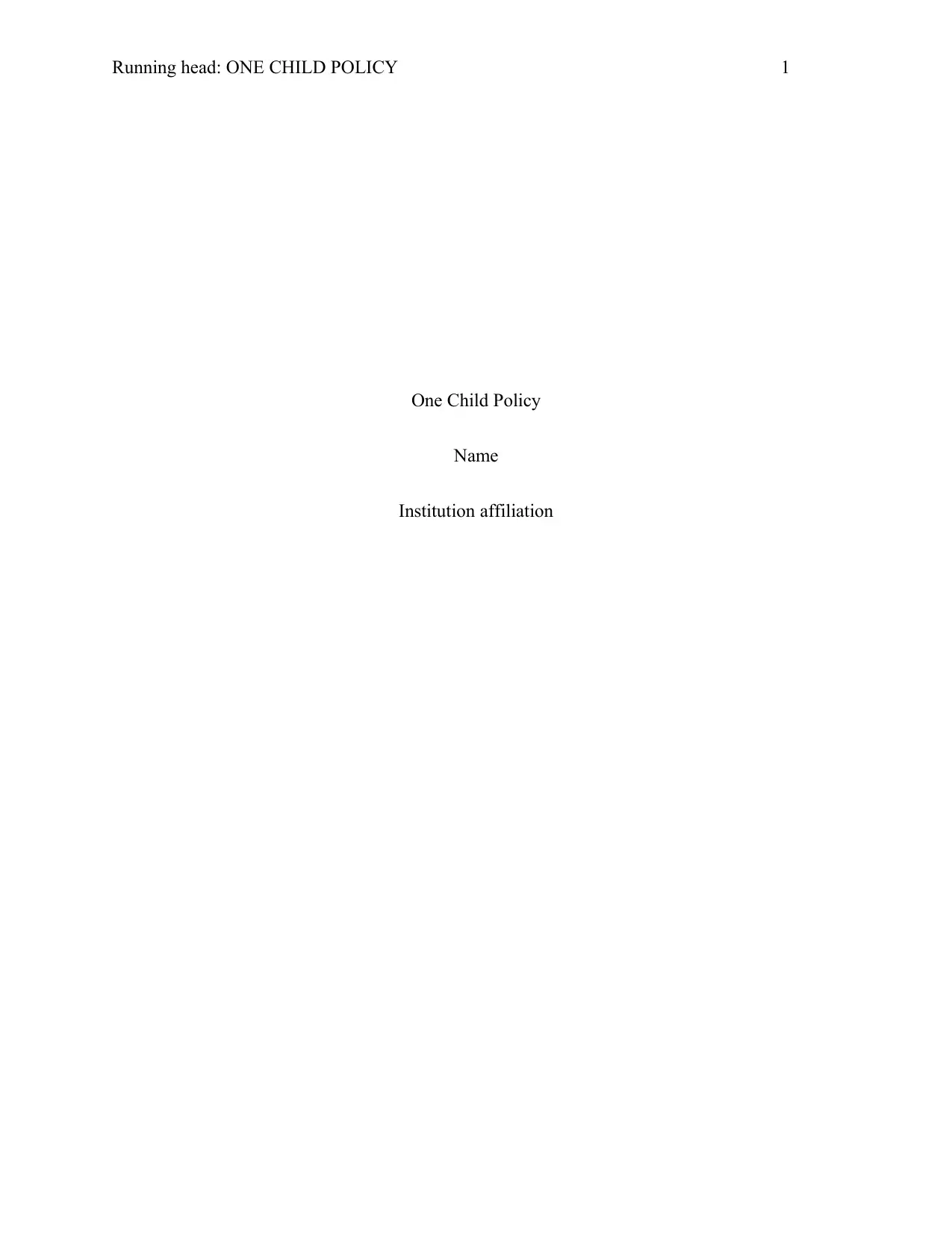
Running head: ONE CHILD POLICY 1
One Child Policy
Name
Institution affiliation
One Child Policy
Name
Institution affiliation
Paraphrase This Document
Need a fresh take? Get an instant paraphrase of this document with our AI Paraphraser
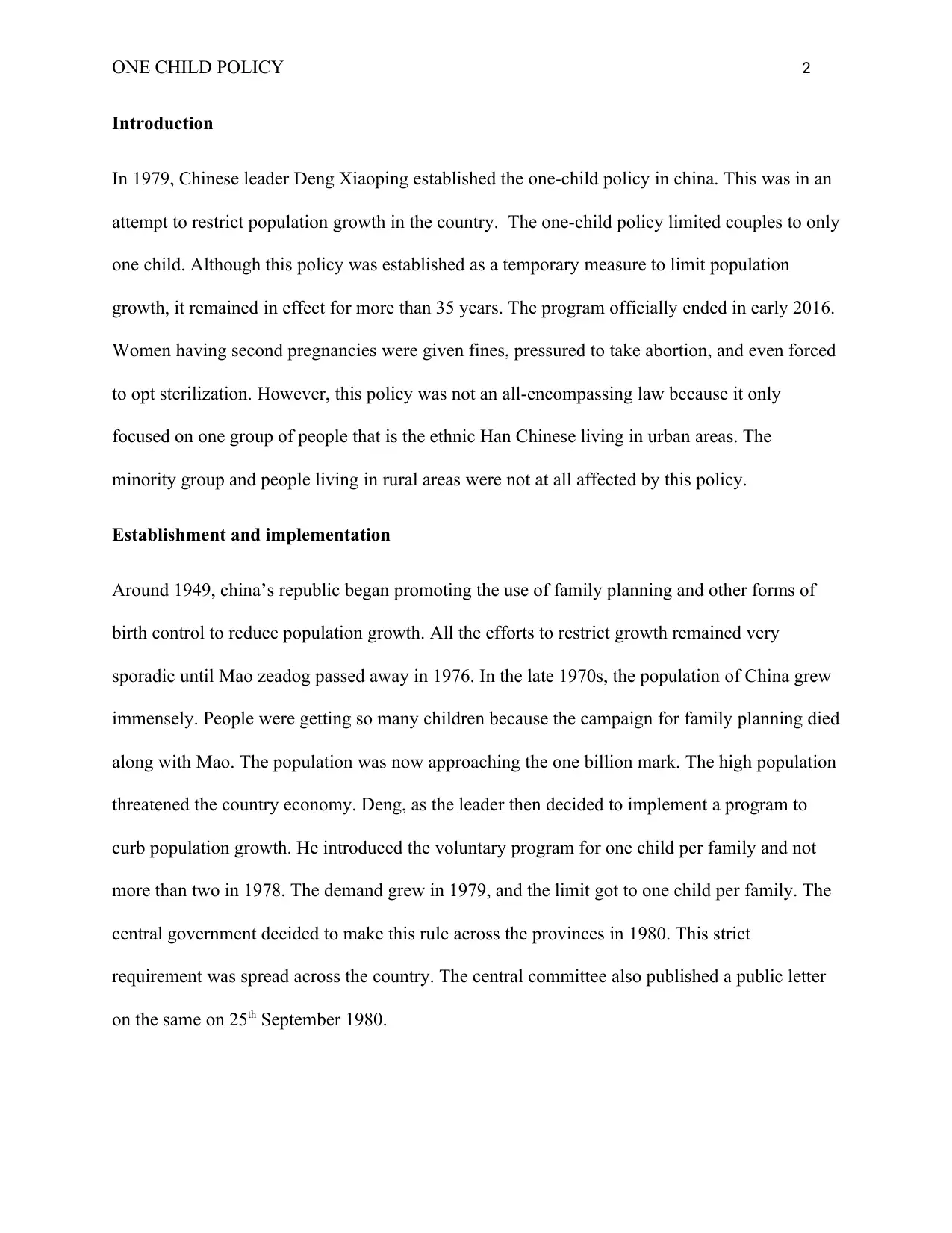
ONE CHILD POLICY 2
Introduction
In 1979, Chinese leader Deng Xiaoping established the one-child policy in china. This was in an
attempt to restrict population growth in the country. The one-child policy limited couples to only
one child. Although this policy was established as a temporary measure to limit population
growth, it remained in effect for more than 35 years. The program officially ended in early 2016.
Women having second pregnancies were given fines, pressured to take abortion, and even forced
to opt sterilization. However, this policy was not an all-encompassing law because it only
focused on one group of people that is the ethnic Han Chinese living in urban areas. The
minority group and people living in rural areas were not at all affected by this policy.
Establishment and implementation
Around 1949, china’s republic began promoting the use of family planning and other forms of
birth control to reduce population growth. All the efforts to restrict growth remained very
sporadic until Mao zeadog passed away in 1976. In the late 1970s, the population of China grew
immensely. People were getting so many children because the campaign for family planning died
along with Mao. The population was now approaching the one billion mark. The high population
threatened the country economy. Deng, as the leader then decided to implement a program to
curb population growth. He introduced the voluntary program for one child per family and not
more than two in 1978. The demand grew in 1979, and the limit got to one child per family. The
central government decided to make this rule across the provinces in 1980. This strict
requirement was spread across the country. The central committee also published a public letter
on the same on 25th September 1980.
Introduction
In 1979, Chinese leader Deng Xiaoping established the one-child policy in china. This was in an
attempt to restrict population growth in the country. The one-child policy limited couples to only
one child. Although this policy was established as a temporary measure to limit population
growth, it remained in effect for more than 35 years. The program officially ended in early 2016.
Women having second pregnancies were given fines, pressured to take abortion, and even forced
to opt sterilization. However, this policy was not an all-encompassing law because it only
focused on one group of people that is the ethnic Han Chinese living in urban areas. The
minority group and people living in rural areas were not at all affected by this policy.
Establishment and implementation
Around 1949, china’s republic began promoting the use of family planning and other forms of
birth control to reduce population growth. All the efforts to restrict growth remained very
sporadic until Mao zeadog passed away in 1976. In the late 1970s, the population of China grew
immensely. People were getting so many children because the campaign for family planning died
along with Mao. The population was now approaching the one billion mark. The high population
threatened the country economy. Deng, as the leader then decided to implement a program to
curb population growth. He introduced the voluntary program for one child per family and not
more than two in 1978. The demand grew in 1979, and the limit got to one child per family. The
central government decided to make this rule across the provinces in 1980. This strict
requirement was spread across the country. The central committee also published a public letter
on the same on 25th September 1980.
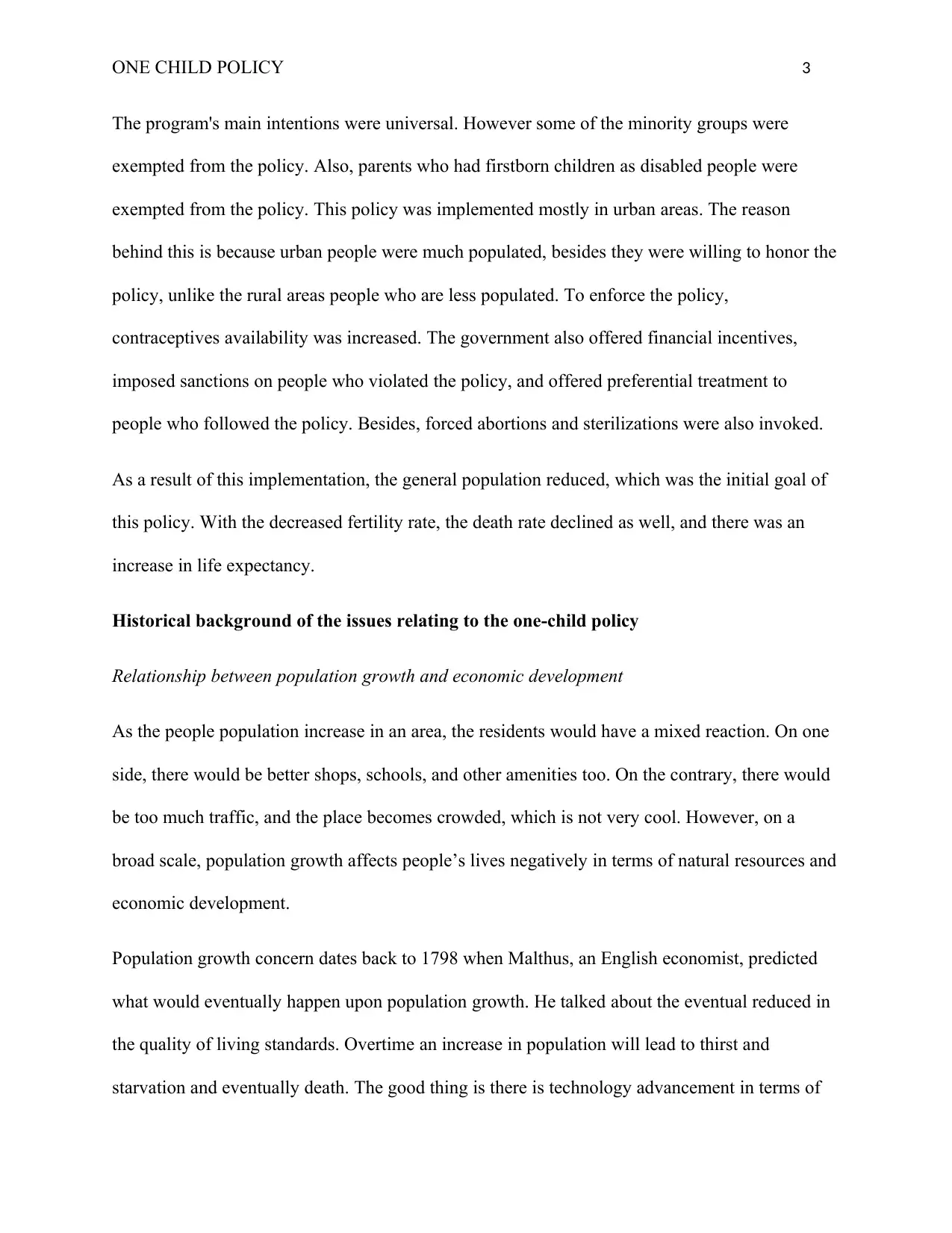
ONE CHILD POLICY 3
The program's main intentions were universal. However some of the minority groups were
exempted from the policy. Also, parents who had firstborn children as disabled people were
exempted from the policy. This policy was implemented mostly in urban areas. The reason
behind this is because urban people were much populated, besides they were willing to honor the
policy, unlike the rural areas people who are less populated. To enforce the policy,
contraceptives availability was increased. The government also offered financial incentives,
imposed sanctions on people who violated the policy, and offered preferential treatment to
people who followed the policy. Besides, forced abortions and sterilizations were also invoked.
As a result of this implementation, the general population reduced, which was the initial goal of
this policy. With the decreased fertility rate, the death rate declined as well, and there was an
increase in life expectancy.
Historical background of the issues relating to the one-child policy
Relationship between population growth and economic development
As the people population increase in an area, the residents would have a mixed reaction. On one
side, there would be better shops, schools, and other amenities too. On the contrary, there would
be too much traffic, and the place becomes crowded, which is not very cool. However, on a
broad scale, population growth affects people’s lives negatively in terms of natural resources and
economic development.
Population growth concern dates back to 1798 when Malthus, an English economist, predicted
what would eventually happen upon population growth. He talked about the eventual reduced in
the quality of living standards. Overtime an increase in population will lead to thirst and
starvation and eventually death. The good thing is there is technology advancement in terms of
The program's main intentions were universal. However some of the minority groups were
exempted from the policy. Also, parents who had firstborn children as disabled people were
exempted from the policy. This policy was implemented mostly in urban areas. The reason
behind this is because urban people were much populated, besides they were willing to honor the
policy, unlike the rural areas people who are less populated. To enforce the policy,
contraceptives availability was increased. The government also offered financial incentives,
imposed sanctions on people who violated the policy, and offered preferential treatment to
people who followed the policy. Besides, forced abortions and sterilizations were also invoked.
As a result of this implementation, the general population reduced, which was the initial goal of
this policy. With the decreased fertility rate, the death rate declined as well, and there was an
increase in life expectancy.
Historical background of the issues relating to the one-child policy
Relationship between population growth and economic development
As the people population increase in an area, the residents would have a mixed reaction. On one
side, there would be better shops, schools, and other amenities too. On the contrary, there would
be too much traffic, and the place becomes crowded, which is not very cool. However, on a
broad scale, population growth affects people’s lives negatively in terms of natural resources and
economic development.
Population growth concern dates back to 1798 when Malthus, an English economist, predicted
what would eventually happen upon population growth. He talked about the eventual reduced in
the quality of living standards. Overtime an increase in population will lead to thirst and
starvation and eventually death. The good thing is there is technology advancement in terms of
⊘ This is a preview!⊘
Do you want full access?
Subscribe today to unlock all pages.

Trusted by 1+ million students worldwide
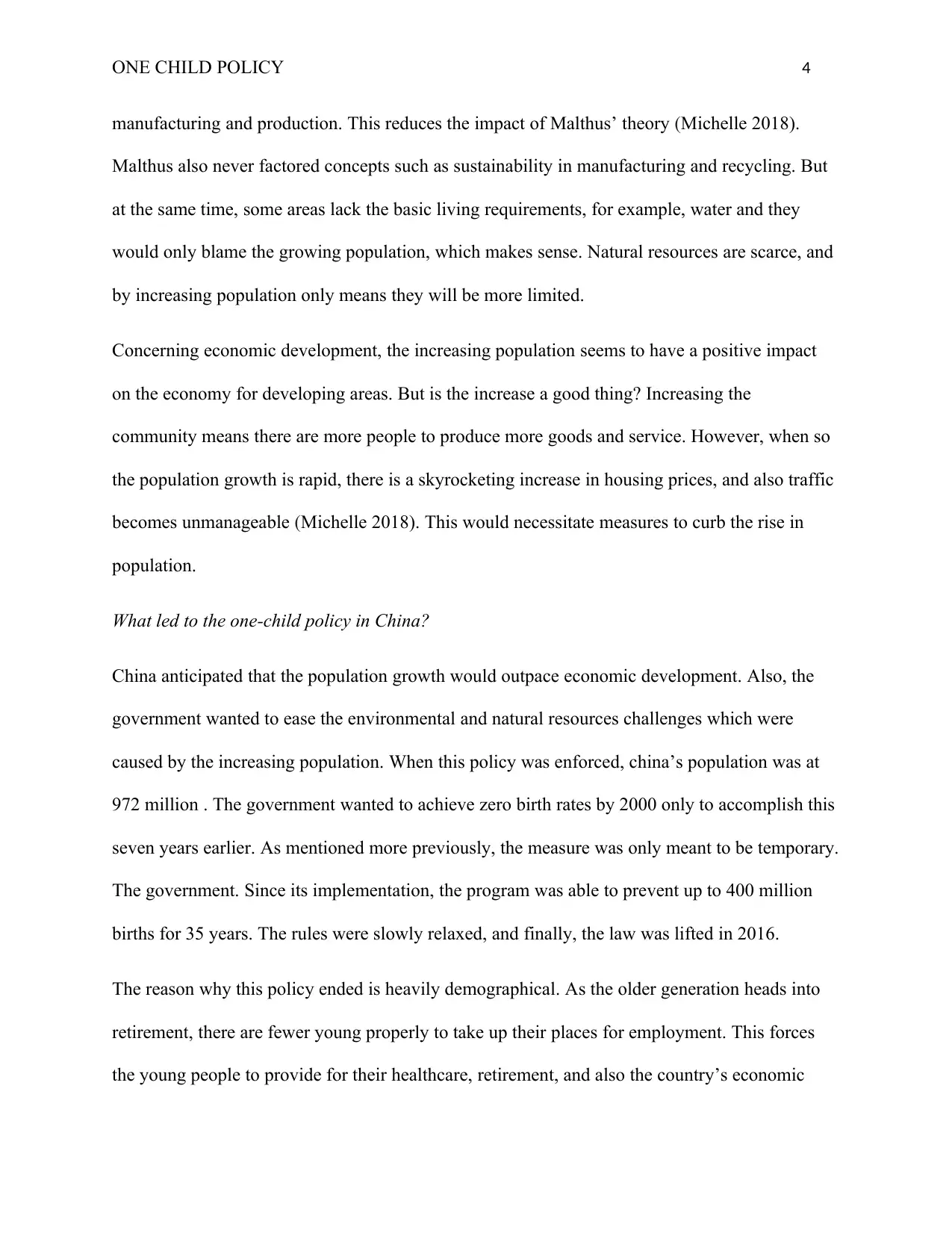
ONE CHILD POLICY 4
manufacturing and production. This reduces the impact of Malthus’ theory (Michelle 2018).
Malthus also never factored concepts such as sustainability in manufacturing and recycling. But
at the same time, some areas lack the basic living requirements, for example, water and they
would only blame the growing population, which makes sense. Natural resources are scarce, and
by increasing population only means they will be more limited.
Concerning economic development, the increasing population seems to have a positive impact
on the economy for developing areas. But is the increase a good thing? Increasing the
community means there are more people to produce more goods and service. However, when so
the population growth is rapid, there is a skyrocketing increase in housing prices, and also traffic
becomes unmanageable (Michelle 2018). This would necessitate measures to curb the rise in
population.
What led to the one-child policy in China?
China anticipated that the population growth would outpace economic development. Also, the
government wanted to ease the environmental and natural resources challenges which were
caused by the increasing population. When this policy was enforced, china’s population was at
972 million . The government wanted to achieve zero birth rates by 2000 only to accomplish this
seven years earlier. As mentioned more previously, the measure was only meant to be temporary.
The government. Since its implementation, the program was able to prevent up to 400 million
births for 35 years. The rules were slowly relaxed, and finally, the law was lifted in 2016.
The reason why this policy ended is heavily demographical. As the older generation heads into
retirement, there are fewer young properly to take up their places for employment. This forces
the young people to provide for their healthcare, retirement, and also the country’s economic
manufacturing and production. This reduces the impact of Malthus’ theory (Michelle 2018).
Malthus also never factored concepts such as sustainability in manufacturing and recycling. But
at the same time, some areas lack the basic living requirements, for example, water and they
would only blame the growing population, which makes sense. Natural resources are scarce, and
by increasing population only means they will be more limited.
Concerning economic development, the increasing population seems to have a positive impact
on the economy for developing areas. But is the increase a good thing? Increasing the
community means there are more people to produce more goods and service. However, when so
the population growth is rapid, there is a skyrocketing increase in housing prices, and also traffic
becomes unmanageable (Michelle 2018). This would necessitate measures to curb the rise in
population.
What led to the one-child policy in China?
China anticipated that the population growth would outpace economic development. Also, the
government wanted to ease the environmental and natural resources challenges which were
caused by the increasing population. When this policy was enforced, china’s population was at
972 million . The government wanted to achieve zero birth rates by 2000 only to accomplish this
seven years earlier. As mentioned more previously, the measure was only meant to be temporary.
The government. Since its implementation, the program was able to prevent up to 400 million
births for 35 years. The rules were slowly relaxed, and finally, the law was lifted in 2016.
The reason why this policy ended is heavily demographical. As the older generation heads into
retirement, there are fewer young properly to take up their places for employment. This forces
the young people to provide for their healthcare, retirement, and also the country’s economic
Paraphrase This Document
Need a fresh take? Get an instant paraphrase of this document with our AI Paraphraser
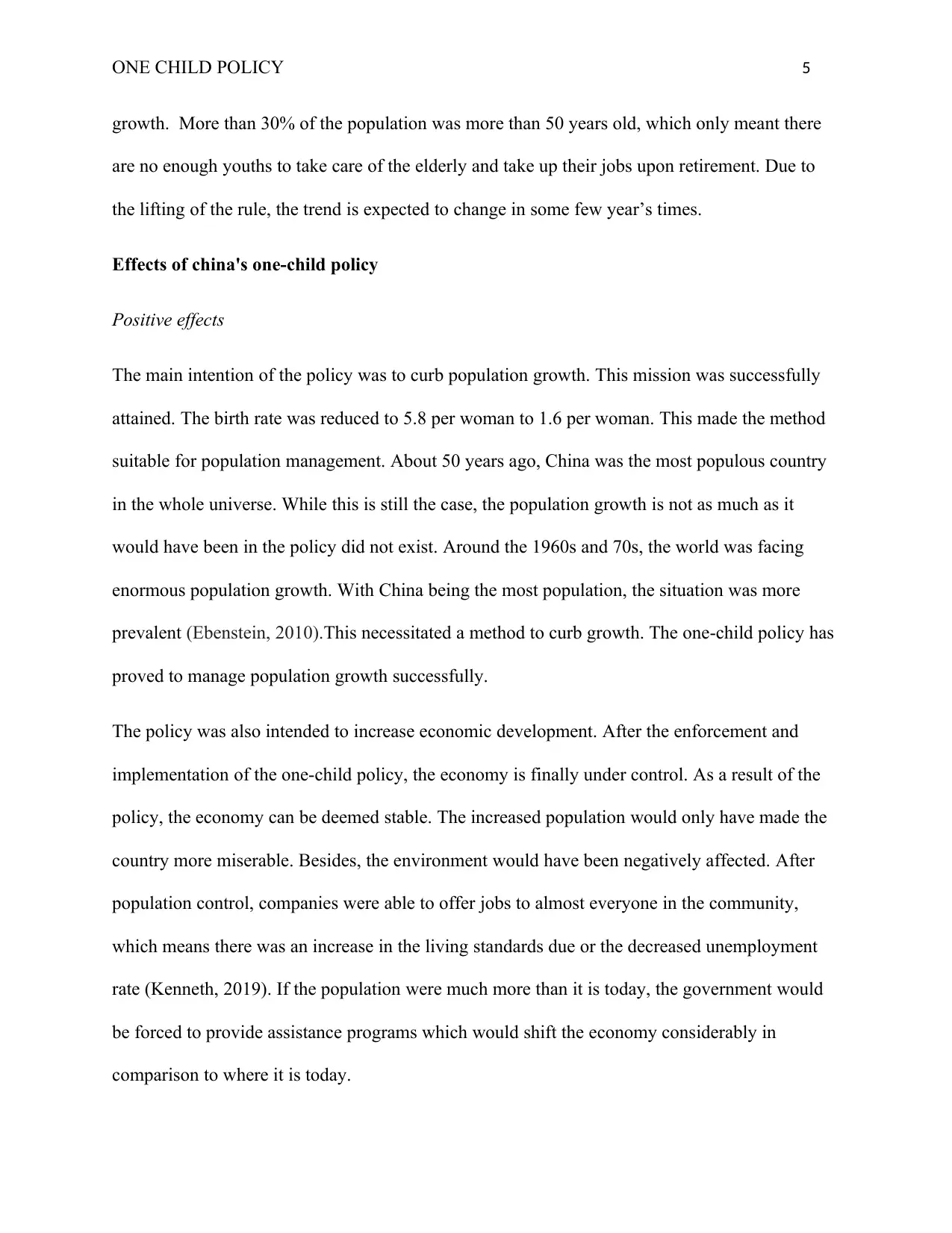
ONE CHILD POLICY 5
growth. More than 30% of the population was more than 50 years old, which only meant there
are no enough youths to take care of the elderly and take up their jobs upon retirement. Due to
the lifting of the rule, the trend is expected to change in some few year’s times.
Effects of china's one-child policy
Positive effects
The main intention of the policy was to curb population growth. This mission was successfully
attained. The birth rate was reduced to 5.8 per woman to 1.6 per woman. This made the method
suitable for population management. About 50 years ago, China was the most populous country
in the whole universe. While this is still the case, the population growth is not as much as it
would have been in the policy did not exist. Around the 1960s and 70s, the world was facing
enormous population growth. With China being the most population, the situation was more
prevalent (Ebenstein, 2010).This necessitated a method to curb growth. The one-child policy has
proved to manage population growth successfully.
The policy was also intended to increase economic development. After the enforcement and
implementation of the one-child policy, the economy is finally under control. As a result of the
policy, the economy can be deemed stable. The increased population would only have made the
country more miserable. Besides, the environment would have been negatively affected. After
population control, companies were able to offer jobs to almost everyone in the community,
which means there was an increase in the living standards due or the decreased unemployment
rate (Kenneth, 2019). If the population were much more than it is today, the government would
be forced to provide assistance programs which would shift the economy considerably in
comparison to where it is today.
growth. More than 30% of the population was more than 50 years old, which only meant there
are no enough youths to take care of the elderly and take up their jobs upon retirement. Due to
the lifting of the rule, the trend is expected to change in some few year’s times.
Effects of china's one-child policy
Positive effects
The main intention of the policy was to curb population growth. This mission was successfully
attained. The birth rate was reduced to 5.8 per woman to 1.6 per woman. This made the method
suitable for population management. About 50 years ago, China was the most populous country
in the whole universe. While this is still the case, the population growth is not as much as it
would have been in the policy did not exist. Around the 1960s and 70s, the world was facing
enormous population growth. With China being the most population, the situation was more
prevalent (Ebenstein, 2010).This necessitated a method to curb growth. The one-child policy has
proved to manage population growth successfully.
The policy was also intended to increase economic development. After the enforcement and
implementation of the one-child policy, the economy is finally under control. As a result of the
policy, the economy can be deemed stable. The increased population would only have made the
country more miserable. Besides, the environment would have been negatively affected. After
population control, companies were able to offer jobs to almost everyone in the community,
which means there was an increase in the living standards due or the decreased unemployment
rate (Kenneth, 2019). If the population were much more than it is today, the government would
be forced to provide assistance programs which would shift the economy considerably in
comparison to where it is today.
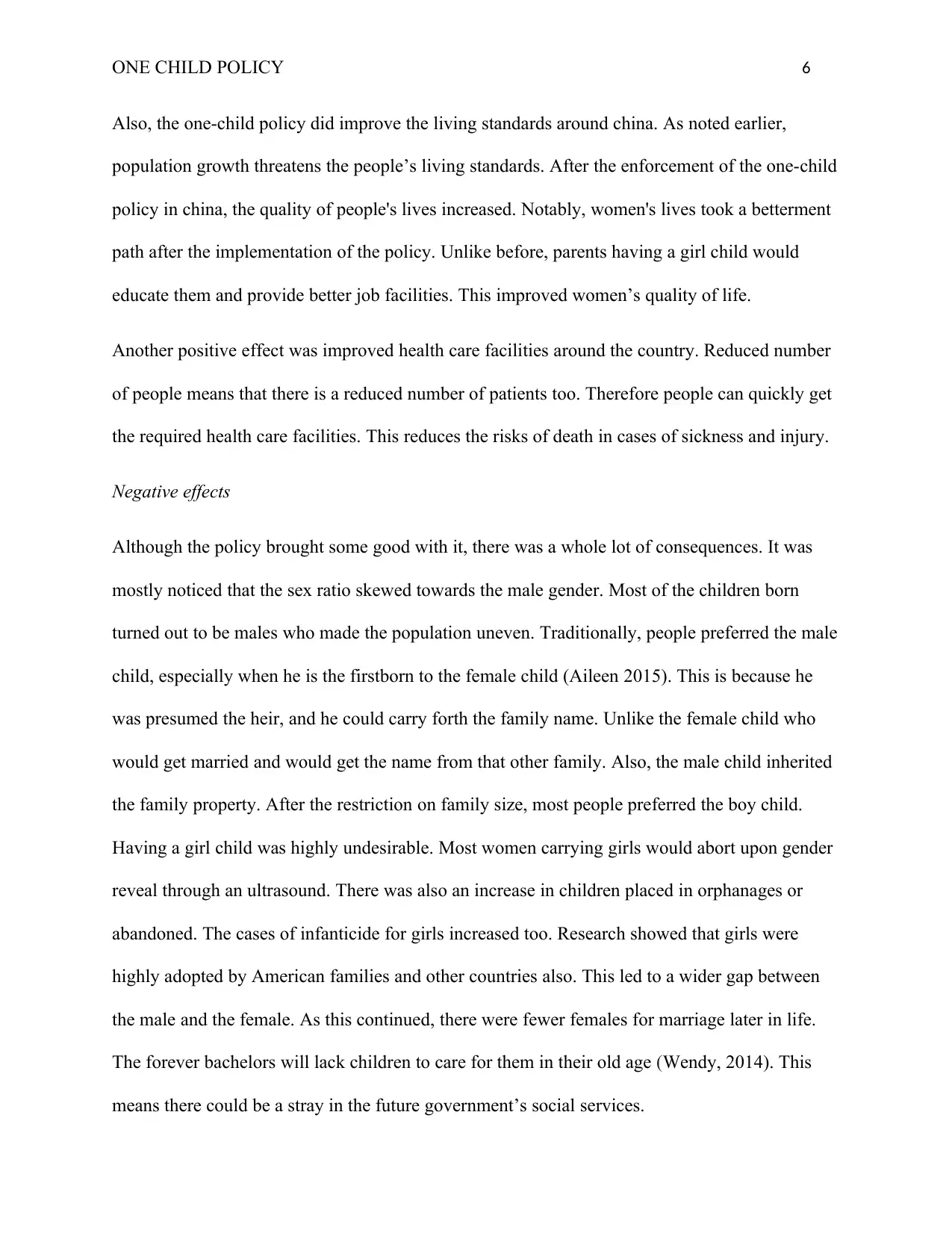
ONE CHILD POLICY 6
Also, the one-child policy did improve the living standards around china. As noted earlier,
population growth threatens the people’s living standards. After the enforcement of the one-child
policy in china, the quality of people's lives increased. Notably, women's lives took a betterment
path after the implementation of the policy. Unlike before, parents having a girl child would
educate them and provide better job facilities. This improved women’s quality of life.
Another positive effect was improved health care facilities around the country. Reduced number
of people means that there is a reduced number of patients too. Therefore people can quickly get
the required health care facilities. This reduces the risks of death in cases of sickness and injury.
Negative effects
Although the policy brought some good with it, there was a whole lot of consequences. It was
mostly noticed that the sex ratio skewed towards the male gender. Most of the children born
turned out to be males who made the population uneven. Traditionally, people preferred the male
child, especially when he is the firstborn to the female child (Aileen 2015). This is because he
was presumed the heir, and he could carry forth the family name. Unlike the female child who
would get married and would get the name from that other family. Also, the male child inherited
the family property. After the restriction on family size, most people preferred the boy child.
Having a girl child was highly undesirable. Most women carrying girls would abort upon gender
reveal through an ultrasound. There was also an increase in children placed in orphanages or
abandoned. The cases of infanticide for girls increased too. Research showed that girls were
highly adopted by American families and other countries also. This led to a wider gap between
the male and the female. As this continued, there were fewer females for marriage later in life.
The forever bachelors will lack children to care for them in their old age (Wendy, 2014). This
means there could be a stray in the future government’s social services.
Also, the one-child policy did improve the living standards around china. As noted earlier,
population growth threatens the people’s living standards. After the enforcement of the one-child
policy in china, the quality of people's lives increased. Notably, women's lives took a betterment
path after the implementation of the policy. Unlike before, parents having a girl child would
educate them and provide better job facilities. This improved women’s quality of life.
Another positive effect was improved health care facilities around the country. Reduced number
of people means that there is a reduced number of patients too. Therefore people can quickly get
the required health care facilities. This reduces the risks of death in cases of sickness and injury.
Negative effects
Although the policy brought some good with it, there was a whole lot of consequences. It was
mostly noticed that the sex ratio skewed towards the male gender. Most of the children born
turned out to be males who made the population uneven. Traditionally, people preferred the male
child, especially when he is the firstborn to the female child (Aileen 2015). This is because he
was presumed the heir, and he could carry forth the family name. Unlike the female child who
would get married and would get the name from that other family. Also, the male child inherited
the family property. After the restriction on family size, most people preferred the boy child.
Having a girl child was highly undesirable. Most women carrying girls would abort upon gender
reveal through an ultrasound. There was also an increase in children placed in orphanages or
abandoned. The cases of infanticide for girls increased too. Research showed that girls were
highly adopted by American families and other countries also. This led to a wider gap between
the male and the female. As this continued, there were fewer females for marriage later in life.
The forever bachelors will lack children to care for them in their old age (Wendy, 2014). This
means there could be a stray in the future government’s social services.
⊘ This is a preview!⊘
Do you want full access?
Subscribe today to unlock all pages.

Trusted by 1+ million students worldwide
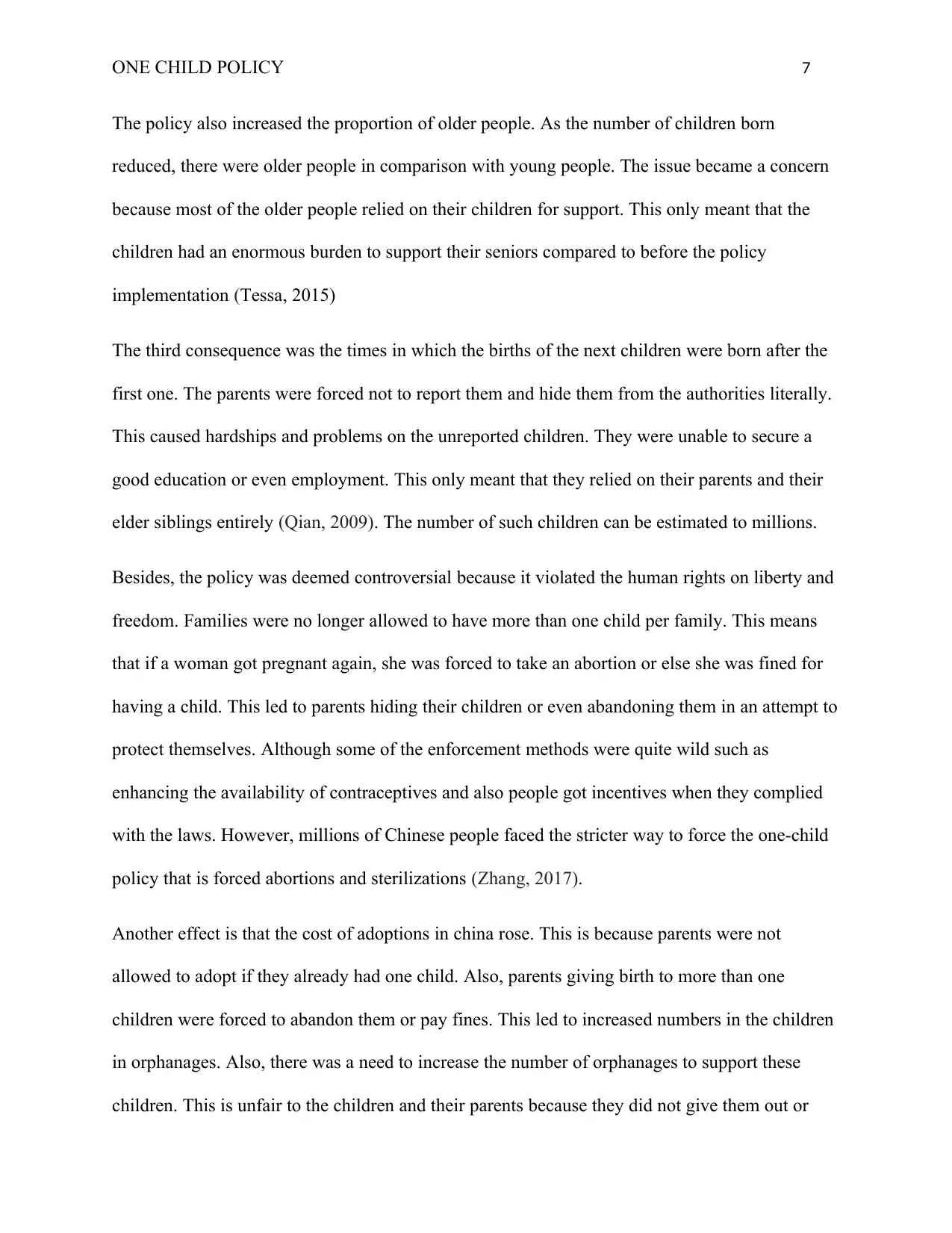
ONE CHILD POLICY 7
The policy also increased the proportion of older people. As the number of children born
reduced, there were older people in comparison with young people. The issue became a concern
because most of the older people relied on their children for support. This only meant that the
children had an enormous burden to support their seniors compared to before the policy
implementation (Tessa, 2015)
The third consequence was the times in which the births of the next children were born after the
first one. The parents were forced not to report them and hide them from the authorities literally.
This caused hardships and problems on the unreported children. They were unable to secure a
good education or even employment. This only meant that they relied on their parents and their
elder siblings entirely (Qian, 2009). The number of such children can be estimated to millions.
Besides, the policy was deemed controversial because it violated the human rights on liberty and
freedom. Families were no longer allowed to have more than one child per family. This means
that if a woman got pregnant again, she was forced to take an abortion or else she was fined for
having a child. This led to parents hiding their children or even abandoning them in an attempt to
protect themselves. Although some of the enforcement methods were quite wild such as
enhancing the availability of contraceptives and also people got incentives when they complied
with the laws. However, millions of Chinese people faced the stricter way to force the one-child
policy that is forced abortions and sterilizations (Zhang, 2017).
Another effect is that the cost of adoptions in china rose. This is because parents were not
allowed to adopt if they already had one child. Also, parents giving birth to more than one
children were forced to abandon them or pay fines. This led to increased numbers in the children
in orphanages. Also, there was a need to increase the number of orphanages to support these
children. This is unfair to the children and their parents because they did not give them out or
The policy also increased the proportion of older people. As the number of children born
reduced, there were older people in comparison with young people. The issue became a concern
because most of the older people relied on their children for support. This only meant that the
children had an enormous burden to support their seniors compared to before the policy
implementation (Tessa, 2015)
The third consequence was the times in which the births of the next children were born after the
first one. The parents were forced not to report them and hide them from the authorities literally.
This caused hardships and problems on the unreported children. They were unable to secure a
good education or even employment. This only meant that they relied on their parents and their
elder siblings entirely (Qian, 2009). The number of such children can be estimated to millions.
Besides, the policy was deemed controversial because it violated the human rights on liberty and
freedom. Families were no longer allowed to have more than one child per family. This means
that if a woman got pregnant again, she was forced to take an abortion or else she was fined for
having a child. This led to parents hiding their children or even abandoning them in an attempt to
protect themselves. Although some of the enforcement methods were quite wild such as
enhancing the availability of contraceptives and also people got incentives when they complied
with the laws. However, millions of Chinese people faced the stricter way to force the one-child
policy that is forced abortions and sterilizations (Zhang, 2017).
Another effect is that the cost of adoptions in china rose. This is because parents were not
allowed to adopt if they already had one child. Also, parents giving birth to more than one
children were forced to abandon them or pay fines. This led to increased numbers in the children
in orphanages. Also, there was a need to increase the number of orphanages to support these
children. This is unfair to the children and their parents because they did not give them out or
Paraphrase This Document
Need a fresh take? Get an instant paraphrase of this document with our AI Paraphraser
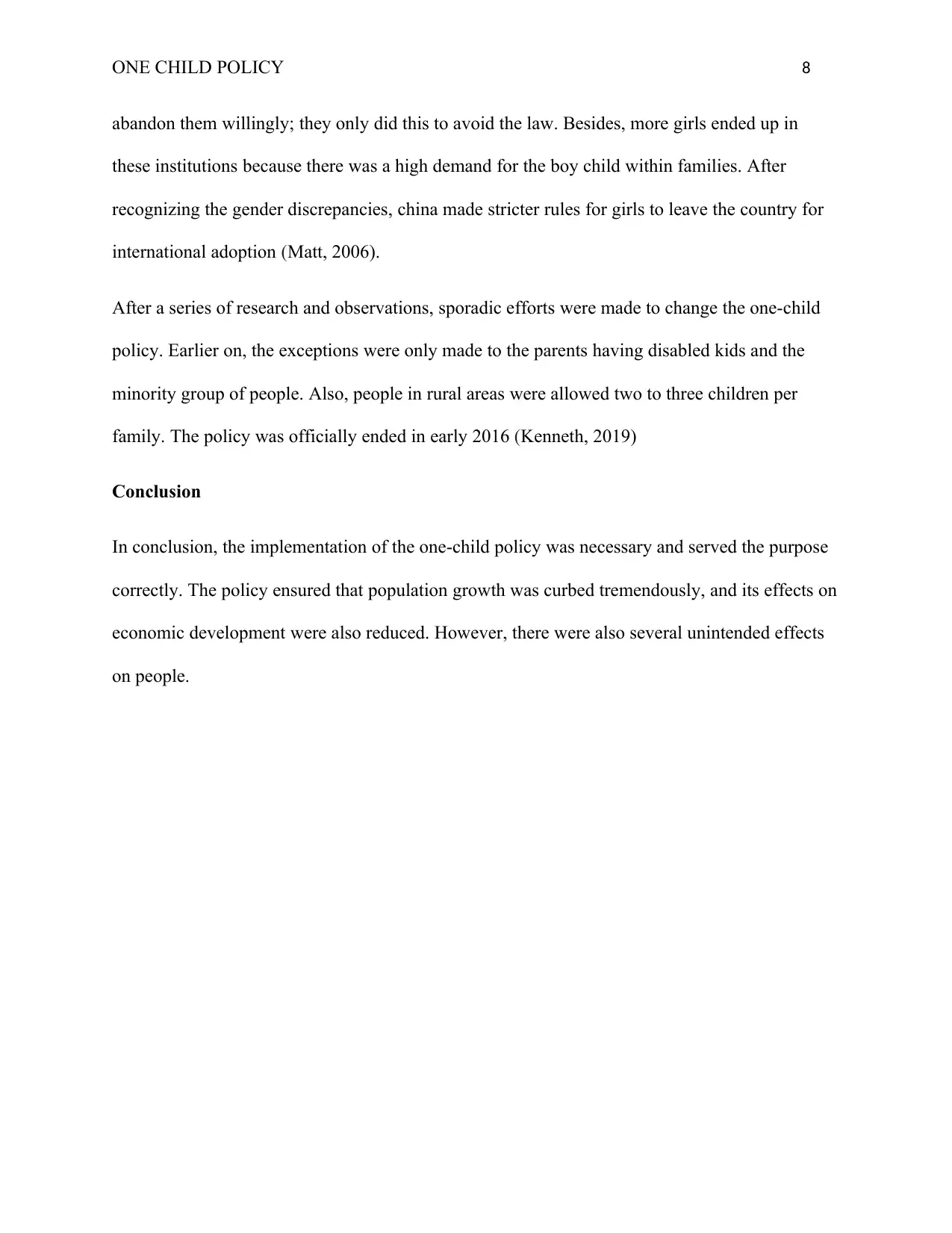
ONE CHILD POLICY 8
abandon them willingly; they only did this to avoid the law. Besides, more girls ended up in
these institutions because there was a high demand for the boy child within families. After
recognizing the gender discrepancies, china made stricter rules for girls to leave the country for
international adoption (Matt, 2006).
After a series of research and observations, sporadic efforts were made to change the one-child
policy. Earlier on, the exceptions were only made to the parents having disabled kids and the
minority group of people. Also, people in rural areas were allowed two to three children per
family. The policy was officially ended in early 2016 (Kenneth, 2019)
Conclusion
In conclusion, the implementation of the one-child policy was necessary and served the purpose
correctly. The policy ensured that population growth was curbed tremendously, and its effects on
economic development were also reduced. However, there were also several unintended effects
on people.
abandon them willingly; they only did this to avoid the law. Besides, more girls ended up in
these institutions because there was a high demand for the boy child within families. After
recognizing the gender discrepancies, china made stricter rules for girls to leave the country for
international adoption (Matt, 2006).
After a series of research and observations, sporadic efforts were made to change the one-child
policy. Earlier on, the exceptions were only made to the parents having disabled kids and the
minority group of people. Also, people in rural areas were allowed two to three children per
family. The policy was officially ended in early 2016 (Kenneth, 2019)
Conclusion
In conclusion, the implementation of the one-child policy was necessary and served the purpose
correctly. The policy ensured that population growth was curbed tremendously, and its effects on
economic development were also reduced. However, there were also several unintended effects
on people.
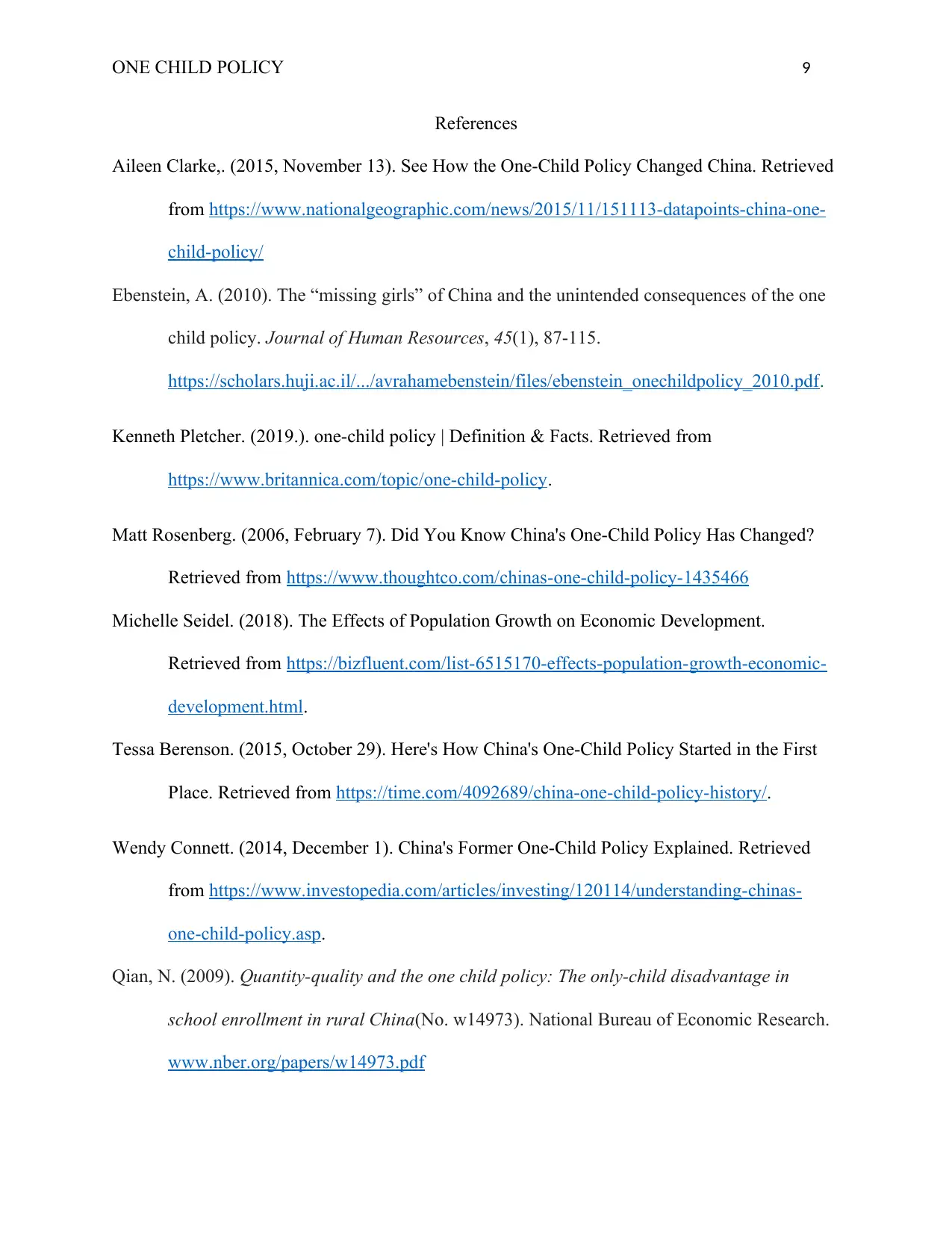
ONE CHILD POLICY 9
References
Aileen Clarke,. (2015, November 13). See How the One-Child Policy Changed China. Retrieved
from https://www.nationalgeographic.com/news/2015/11/151113-datapoints-china-one-
child-policy/
Ebenstein, A. (2010). The “missing girls” of China and the unintended consequences of the one
child policy. Journal of Human Resources, 45(1), 87-115.
https://scholars.huji.ac.il/.../avrahamebenstein/files/ebenstein_onechildpolicy_2010.pdf.
Kenneth Pletcher. (2019.). one-child policy | Definition & Facts. Retrieved from
https://www.britannica.com/topic/one-child-policy.
Matt Rosenberg. (2006, February 7). Did You Know China's One-Child Policy Has Changed?
Retrieved from https://www.thoughtco.com/chinas-one-child-policy-1435466
Michelle Seidel. (2018). The Effects of Population Growth on Economic Development.
Retrieved from https://bizfluent.com/list-6515170-effects-population-growth-economic-
development.html.
Tessa Berenson. (2015, October 29). Here's How China's One-Child Policy Started in the First
Place. Retrieved from https://time.com/4092689/china-one-child-policy-history/.
Wendy Connett. (2014, December 1). China's Former One-Child Policy Explained. Retrieved
from https://www.investopedia.com/articles/investing/120114/understanding-chinas-
one-child-policy.asp.
Qian, N. (2009). Quantity-quality and the one child policy: The only-child disadvantage in
school enrollment in rural China(No. w14973). National Bureau of Economic Research.
www.nber.org/papers/w14973.pdf
References
Aileen Clarke,. (2015, November 13). See How the One-Child Policy Changed China. Retrieved
from https://www.nationalgeographic.com/news/2015/11/151113-datapoints-china-one-
child-policy/
Ebenstein, A. (2010). The “missing girls” of China and the unintended consequences of the one
child policy. Journal of Human Resources, 45(1), 87-115.
https://scholars.huji.ac.il/.../avrahamebenstein/files/ebenstein_onechildpolicy_2010.pdf.
Kenneth Pletcher. (2019.). one-child policy | Definition & Facts. Retrieved from
https://www.britannica.com/topic/one-child-policy.
Matt Rosenberg. (2006, February 7). Did You Know China's One-Child Policy Has Changed?
Retrieved from https://www.thoughtco.com/chinas-one-child-policy-1435466
Michelle Seidel. (2018). The Effects of Population Growth on Economic Development.
Retrieved from https://bizfluent.com/list-6515170-effects-population-growth-economic-
development.html.
Tessa Berenson. (2015, October 29). Here's How China's One-Child Policy Started in the First
Place. Retrieved from https://time.com/4092689/china-one-child-policy-history/.
Wendy Connett. (2014, December 1). China's Former One-Child Policy Explained. Retrieved
from https://www.investopedia.com/articles/investing/120114/understanding-chinas-
one-child-policy.asp.
Qian, N. (2009). Quantity-quality and the one child policy: The only-child disadvantage in
school enrollment in rural China(No. w14973). National Bureau of Economic Research.
www.nber.org/papers/w14973.pdf
⊘ This is a preview!⊘
Do you want full access?
Subscribe today to unlock all pages.

Trusted by 1+ million students worldwide
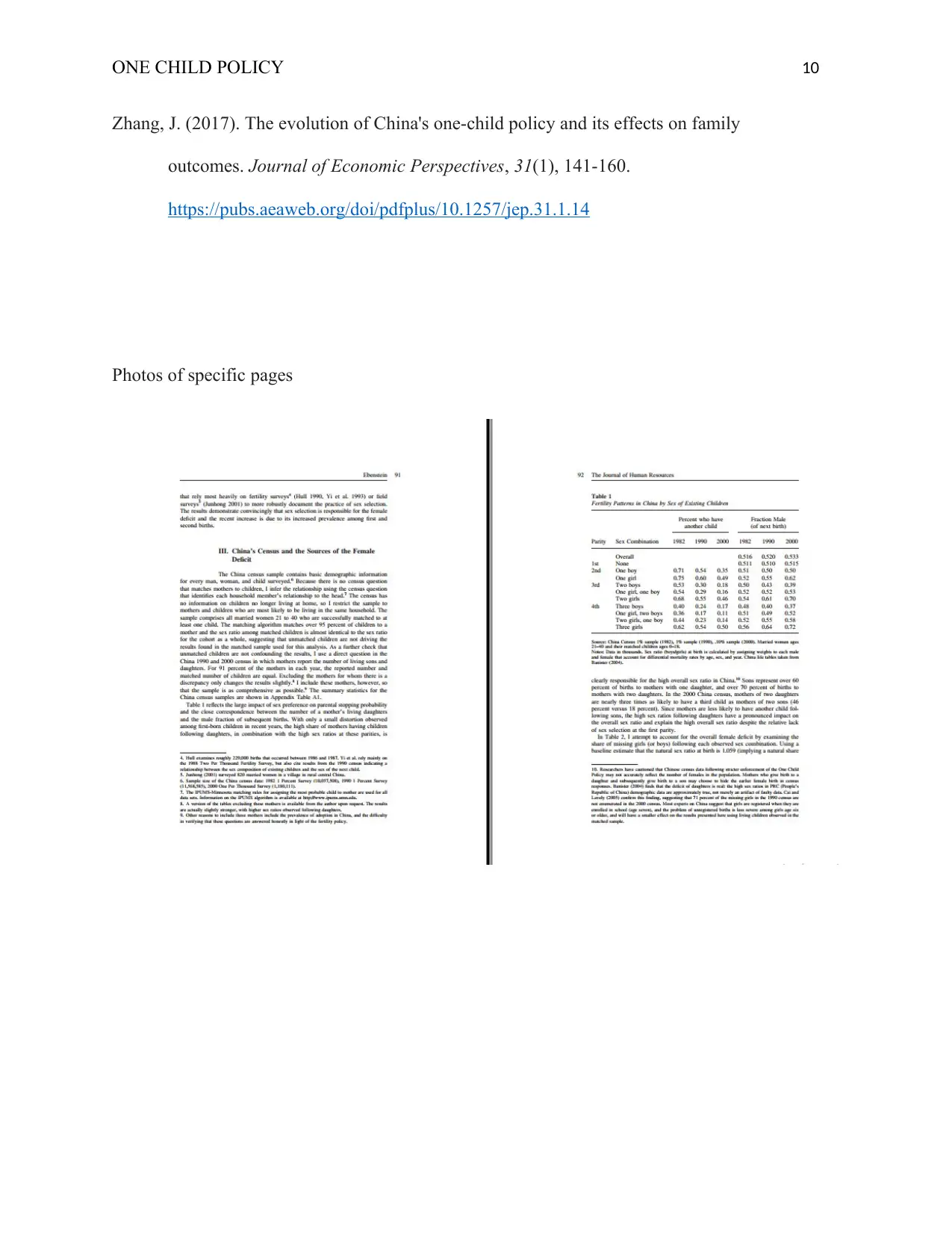
ONE CHILD POLICY 10
Zhang, J. (2017). The evolution of China's one-child policy and its effects on family
outcomes. Journal of Economic Perspectives, 31(1), 141-160.
https://pubs.aeaweb.org/doi/pdfplus/10.1257/jep.31.1.14
Photos of specific pages
Zhang, J. (2017). The evolution of China's one-child policy and its effects on family
outcomes. Journal of Economic Perspectives, 31(1), 141-160.
https://pubs.aeaweb.org/doi/pdfplus/10.1257/jep.31.1.14
Photos of specific pages
Paraphrase This Document
Need a fresh take? Get an instant paraphrase of this document with our AI Paraphraser
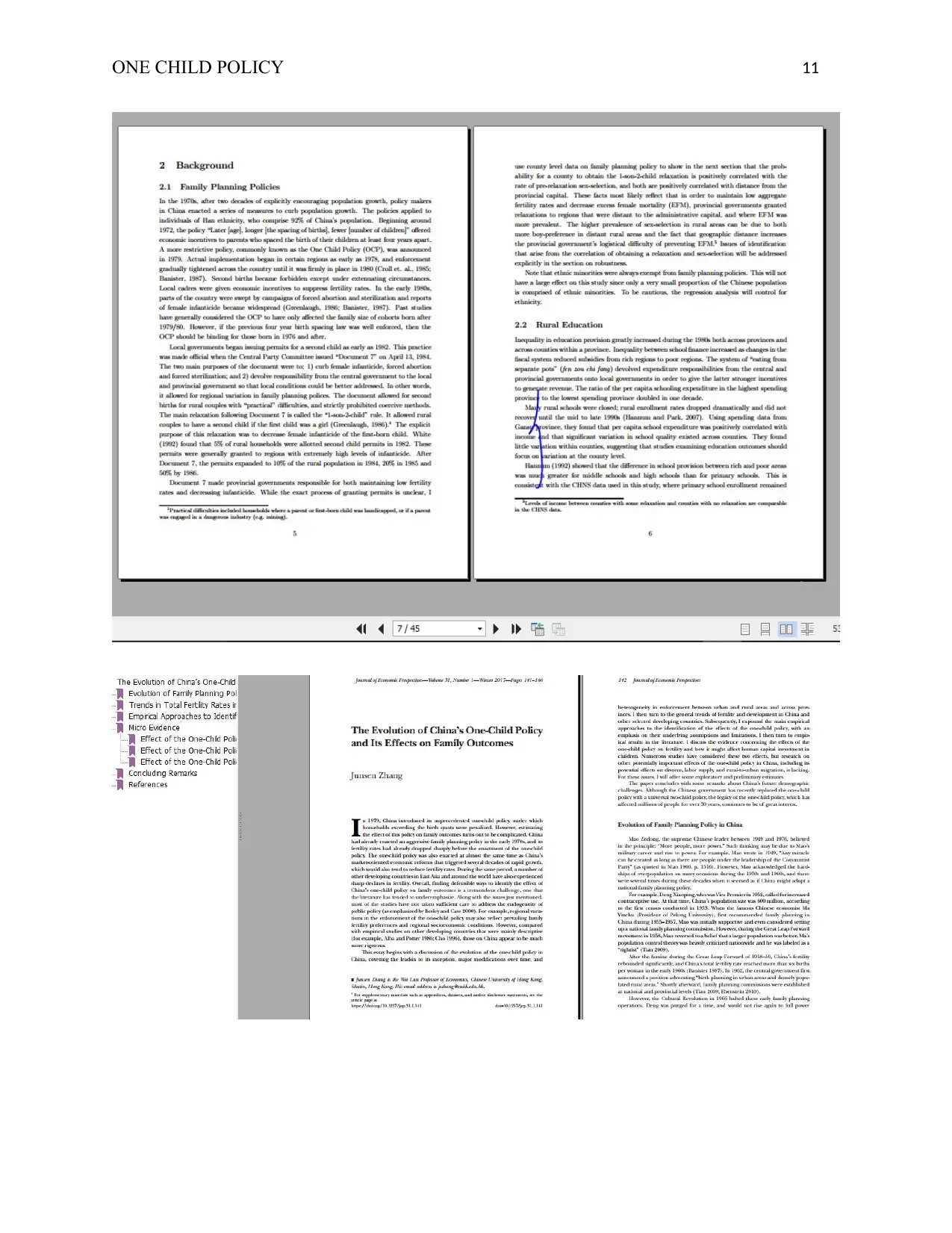
ONE CHILD POLICY 11
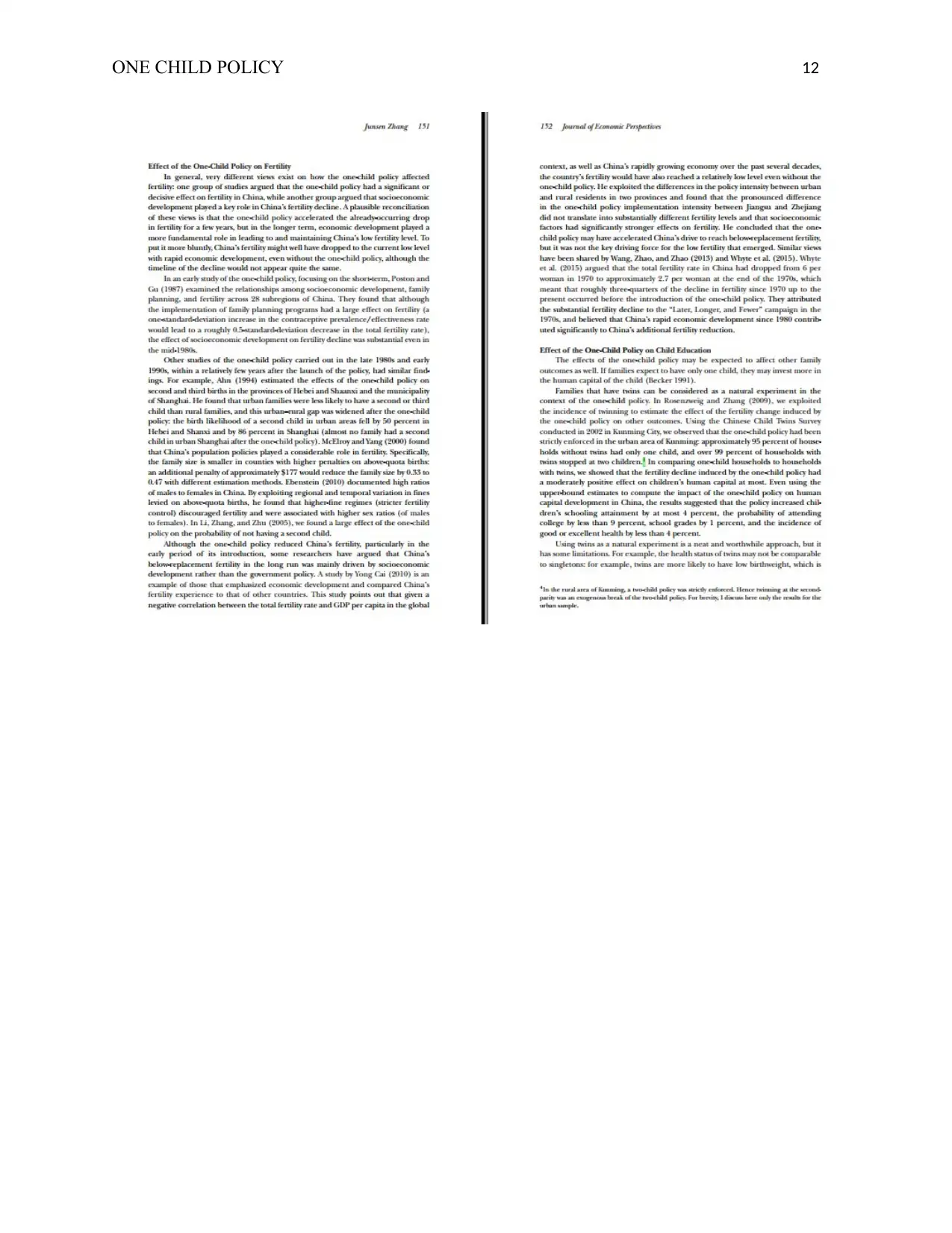
ONE CHILD POLICY 12
⊘ This is a preview!⊘
Do you want full access?
Subscribe today to unlock all pages.

Trusted by 1+ million students worldwide
1 out of 13
Related Documents
Your All-in-One AI-Powered Toolkit for Academic Success.
+13062052269
info@desklib.com
Available 24*7 on WhatsApp / Email
![[object Object]](/_next/static/media/star-bottom.7253800d.svg)
Unlock your academic potential
Copyright © 2020–2025 A2Z Services. All Rights Reserved. Developed and managed by ZUCOL.





